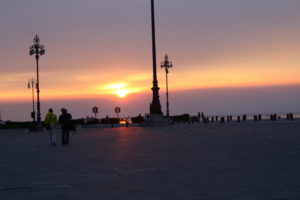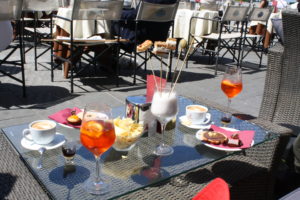Recently, I read this article in both the Wall Street Journal and from a trusted travel source.
U.S. citizens traveling to Europe will shortly need to apply for an ETIAS (European Travel Information and Authorization System) visa waiver which is the new travel authorization for Europe that will come into effect in 2021. Similar to other countries and regions in the world, Europe has recently decided to improve its security level to avoid any further problems with illegal immigration and terrorism.
This means that, by the end of 2021,
all Americans traveling to a European country in the Schengen Zone will be in
need of an ETIAS. The Schengen Area is composed of 22 European Union countries
like France, Italy, Germany, Sweden, and Spain, as well as 4 non-EU countries:
Iceland, Lichtenstein, Norway, and Switzerland. ETIAS will permit travel
to all Schengen countries for short stays during its validity.
HOW LONG CAN A
US CITIZEN STAY IN EUROPE?
At the moment, there is no Europe visa waiver for U.S. citizens for periods of less
than 90 days. However, this will change by the end of 2021, when American
citizens traveling to Europe from the U.S. will require an ETIAS visa
waiver to travel to any of the Schengen zone countries for short stays.
The ETIAS visa waiver for Americans
is a multiple-entry travel authorization valid for a total of 3 years
from the moment of approval. During the 3-year
validity of the ETIAS for U.S. travelers, it is
possible to enter any of the Schengen Zone European countries which apply to
the travel authorization as many times as necessary.
The total stay allowed in a Schengen
country with each entry with ETIAS is 90 days within every 180-day
period. ETIAS permits travel to Schengen countries for short stays for
tourism, business, medical treatment, or transit purposes. To stay for longer
periods of time or other purposes, American citizens are required to
apply for a Schengen
visa from an embassy or consulate.
Currently, there are 22 European
countries that form part of the Schengen Area. They include:
- Austria
- Belgium
- Luxembourg
- Netherlands
- Germany
- France
- Spain
- Portugal
- Sweden
- Finland
- Denmark
- Lithuania
- Latvia
- Estonia
- Poland
- Slovakia
- Hungary
- Slovenia
- Italy
- Greece
- Czech Republic
- Malta
EITAS Required in Non-EU Member States include:
- Iceland
- Liechtenstein
- Norway
- Switzerland
Also included are:
- Monaco
- San Marino
- Vatican City
EITAS Non-Required include:
- United Kingdom
- Republic of Ireland
- Romania
- Bulgaria
- Croatia
- Cyprus
WHAT DO AMERICANS NEED TO GO TO EUROPE?
To obtain the Europe visa waiver for
Americans, U.S. citizens will need to have a valid passport, a credit or debit
card to pay the
ETIAS fee, and an email account. These are the
main ETIAS requirements for U.S. citizens which each applicant must
have on hand when applying. Without the right travel document, applicants could
have their application denied.
When applying for an ETIAS,
applicants must ensure that the passport used is valid for 3 months beyond
the period of intended stay of each person. It is possible that passports over
10 years old may not be accepted as a valid travel document.
Applicants with dual nationality, and so
multiple passports, should ensure they use the same passport to complete the
ETIAS application as that which they will later use to travel to the Schengen
Area, as the ETIAS will be electronically linked to an individual passport.
When applying for an electronic visa
waiver for Europe, it is necessary to provide a current email address at
which to receive a copy of the approved ETIAS. As an approved ETIAS is
electronically linked to the traveler’s passport, it will not be mandatory
to print a copy of the visa waiver, although travelers are nonetheless advised
to carry a copy with them to Europe in case of any problems with the electronic
system.
TRAVELING TO EUROPE FROM THE U.S WITH ETIAS
When submitting an ETIAS application, it
is important to remember that all U.S. citizens will be required to obtain
an ETIAS to travel to Europe from 2021, including minors. It is necessary to
submit a separate visa waiver for Europe application for all U.S. children
under the age of 18. Parents or legal guardians are able to submit a
European visa waiver application on behalf of a minor, although every child
is required to have an individual approved ETIAS.
It is also important to note that an
approved ETIAS for American citizens does not guarantee entry to Europe, it merely
grants the holder permission to travel to Schengen countries. The final
decision for entry will be made by an immigration officer at Schengen border
control. The traveler may be asked to prove they do not intend to spend
longer in Europe than the period allowed with ETIAS, by providing evidence of:
- Return flight tickets to the United
States or tickets to an onward destination
- Proof of travel health insurance
- Proof of sufficient funds to cover
the stay
There will also be other regulations
and restrictions to bear in mind when traveling to Europe from the U.S.A. which
are similar to those in place at the moment, such as the right to carry
weapons, importing and exporting large quantities of tobacco, alcohol or
perfume, and declaring large amounts of currency.
Finally, it is important to note that
an ETIAS may be revoked when the conditions for the issuing of the visa
waiver for Europe are no longer met, particularly when there is reason to
believe that the visa waiver for Europe was obtained by providing misleading or
fraudulent information. For this reason it is essential to ensure that all of
the information provided on the ETIAS form is correct before submitting the
application, as even small errors may result in the revocation
of an ETIAS.
Travelers whose passport expires during
the validity of the ETIAS are also required to submit a new application
for a Europe visa waiver from the United States in order to continue to
travel to the Schengen Area, as an ETIAS is specifically linked to the
travel document used to complete the original application.
DO AMERICAN CITIZENS NEED A VISA FOR EUROPE (SCHENGEN
VISA)?
As the United States is one of the visa-exempt
countries for Europe, American citizens do not currently require a visa for the
Schengen Area for short stays up to 90 days. From 2021, however, they will be
required to obtain an Europe visa waiver to stay in Schengen countries for any
less than 90 days. There is no need to apply before every trip, as ETIAS
permits travel to all Schengen countries during its 3-year validity.
American citizens who intend
to stay in Europe for longer periods, or for purposes other than those
permitted with ETIAS, will be required to apply for a Schengen visa. The length
of a Schengen visa for Europe is determined on an individual basis, and it may
be issued as a single-entry, double-entry, or multiple-entry visa. Unlike
ETIAS, a Schengen visa is issued for one specific Schengen country, and
applicants are required to apply in person from an embassy or consulate in the
United States of the country they wish to visit.
SCHENGEN VISA REQUIREMENTS FOR US CITIZENS
It is necessary to attend an consular
appointment for a Schengen visa with the following documentation in order
to guarantee approval of the visa:
- A completed Schengen Europe visa
application form
- Copies of any previously issued Schengen
visas
- A valid US passport containing
at least 2 blank pages
- Any accommodation bookings the
traveler has made for their stay
- Round trip flight tickets, or
tickets to an onward destination
- Proof of sufficient financial means to
cover the stay in Europe
- Travel insurance which covers
medical care in the Schengen Area
- A recent, passport-sized, photograph
of the traveler, taken against a white background
American citizens who apply for a
Schengen visa are required to submit the application at least 15 working days before
the intended date of entry to Europe at the latest, to allow for sufficient
time for the visa to be processed.
HOW CAN AMERICANS APPLY FOR ETIAS TO VISIT EUROPE?
U.S. citizens can apply online for an
ETIAS by completing an online ETIAS registration. The enrollment will be a
quick and simple process, similar
to the ESTA for eligible citizens traveling to
the U.S. and will take an average of 20 minutes to complete. Applicants
will need to fill out an online form with their contact details and
passport information, including:
- Name and surname
- Nationality
- Date, place, and country of birth
- Current address
- Contact phone number
- Email address
- Passport number
- Passport issue/expiry date
This process allows European immigration
and customs authorities to pre-screen all travelers and confirm their
status before permitting them entry or even to board a flight, thus dentifying
any potential threats and improving security measures throughout
the Schengen
Area.
All of the
information provided on the Europe visa waiver application is pre-screened
against the databases managed by eu-LISA (European Union Agency for the
Operational Management of Large-Scale IT Systems in the Area of Freedom,
Security and Justice). eu-LISA is
also responsible for the management of the ETIAS system, and will check
applications against security information databases such as VIS (visa
information database), SIS (shared European database to identify suspected
criminals, missing people, and stolen assets), and EURODAC (fingerprint
database).
It is also necessary
to answer some basic security questions to submit the ETIAS visa waiver
application, including about:
- Criminal
history
- Employment
history
- Drug
use
- Human
trafficking
- Prior
travel to conflict areas
- Past
European travel information
After answering all of the required security questions on the ETIAS form, it is necessary to pay the required ETIAS fee using either a valid credit or debit card. Once the travel authorization for Europe has been paid, the process is complete and the applicant will receive the confirmation for the ETIAS visa waiver via email. With an approved ETIAS visa waiver, applicants will be ready to travel to Europe.
For more information, check out https://www.schengenvisainfo.com/etias/
Let me know if you have more information.










